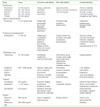The Diagnosis and Most-Updated Therapy of Migraine
Article information
Abstract
Migraine is a very common headache disorder. The international headache society subdivides migraine into the ones with and without aura. The migraine attack can consist of premonitory, aura, headache, and resolution phases. Diagnosis is based on the characteristics of headache and associated symptoms. There are many abortive and preventive migraine treatments. Abortive treatment is either specific for the disease or nonspecific such as analgesics. The migraine specific therapies are representative of new migraine abortive medications, which act as serotonin agonist-triptan and ergot. Stratified care and early treatment are also cost-effective. Increased headache frequency is an indication for a preventive treatment. Preventive treatment decreases migraine frequency and improves quality of life. More treatments are being developed. Several new treatments are reviewed in this article.




